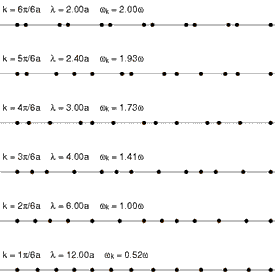Quasiparticles
Quasiparticles are a concept primarily of condensed matter physics. It is not a particle in the true sense of the word, it is an excitation spreading through the given environment, which is convenient, for the purposes of further analysis, to consider as a particle. Quasiparticles can be used to analyze some complex physical phenomena.
Physics[edit | edit source]
Quasi-particles are not particles in the true sense of the word, they are rather an excitation (disorder, excitation) propagating through the system, similar to e.g. the excitation propagating through falling dominoes. The physical nature of quasiparticles can be real particles. Thus, for example, a free electron passing through a semiconductor will, due to multiple interactions, appear as an electron differing from the free electron in effective mass, effective charge, or both. On the other hand, an acoustic excitation propagating through a crystal of a solid can also be modeled by a quasiparticle called a phonon.
Quasiparticles represent a so-called emergent phenomenon, i.e. a property of complex systems that cannot be easily derived from the properties of individual components. A complex system here is usually a system of a number of interacting particles, e.g. a crystal. This means that a quasi-particle does not exist by itself, it is a phenomenon bound to the respective complex system.
Quasiparticles can behave both as bosons and as fermions. In the case of quasiparticles with boson behavior, the term collective excitation. is sometimes used. Quasiparticles can have properties that are unattainable for standard particles. Thus, for example, in the quantum-mechanical Hall effect on thin semiconductors, quasi-particles with an electric charge equal to a fractional part of the elementary charge are used. When studying certain problems in the field of superconductor movement in a magnetic field quasi-particles with the properties of a magnetic monopole appear as a solution.
Quasiparticle Types[edit | edit source]
There are a number of quasi-particles, we mention two examples:
- Phonon is a quasiparticle with boson properties corresponding to a propagating vibrational quantum of energy, usually in a crystal lattice. Very roughly, the phonon can therefore be considered a quasi-particle of sound propagating in solids. The mechanistic idea of such phonons is a propagating elastic oscillation of particles, so the term phonon makes sense only in solids and in some real liquids.
- A hole is a quasiparticle with the properties of a fermion. In the crystal lattice of a semiconductor, it roughly corresponds to a defect in which an electron is missing in the valence layer. When a semiconductor is exposed to an electric field, the hole behaves as a positively charged particle, it is the basis of the so-called hole conductivity in the case of disturbances in the structure of the valence layer of semiconductors, whether thermal disturbances (a free electron and quasi-particle hole are formed during excitation) or permanent disturbances introduced by intentional contamination of the structure at of extrinsic P-type semiconductors.
Related links[edit | edit source]
Sources[edit | edit source]
- CAMINO, F. E.. Anyon There? (Physical Review Focus) [online]. [cit. 2014-05-01]. <https://physics.aps.org/story/v16/st14>.
- CAMINO, F. E.. částice/kvazičástice [online]. [cit. 2014-08-01]. <https://cs.wikipedia.org/wiki/%C4%8C%C3%A1stice>.
- KULHÁNEK, P.. Plazmon [online]. [cit. 2014-08-01]. <https://www.aldebaran.cz/glossary/print.php?id=581>.


